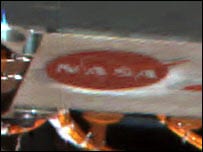When photos supposedly taken by the Mars rovers have the redness reduced in a computer graphics program, the photos appear normal and possibly taken here on earth with filters to enhance the redness. At the link above, the arrow on the sundial shows as blue on earth, but shows as red in the mars picture indicating that filters were used. If a red filter was used, it lowers the intensities of all the other colors, so blue becomes more ‘red’. In addition, the NASA logo, normally blue, also shows as red…
 Critics also claim that interstellar travel is impossible and that NASA inadvertently admitted it on its own web site. The critics say that no man has ever traveled further than 300 miles beyond the surface of the Earth. The tremendous radiation encountered in the Van Allen Belt, solar radiation, cosmic radiation, temperature control, and many other problems connected with space travel prevent living organisms leaving our atmosphere with our known level of technology. It’s scientifically and technologically impossible. As such no man has ever orbited, landed on, or walked upon the moon.
Critics also claim that interstellar travel is impossible and that NASA inadvertently admitted it on its own web site. The critics say that no man has ever traveled further than 300 miles beyond the surface of the Earth. The tremendous radiation encountered in the Van Allen Belt, solar radiation, cosmic radiation, temperature control, and many other problems connected with space travel prevent living organisms leaving our atmosphere with our known level of technology. It’s scientifically and technologically impossible. As such no man has ever orbited, landed on, or walked upon the moon.
To make interstellar travel appear believable NASA was created. The Apollo Space Program created the idea that man could travel to and walk upon the surface of the moon. Up until now, every Apollo mission has been carefully rehearsed and then filmed in a large sound stage at the Atomic Energy Commissions Top Secret test site in the Nevada Desert.
Post-production facilities housing state-of-the-art Computer Generated Imagery (CGI) technology and advanced HD digital animation specialists are located in a secondary studio in a secured and guarded basement at the Pixar studios in Emeryville, California.
Pixar are the developers of their proprietary software system RenderMan, a hi-tech computer animated rendering system that produces high quality, photo-realistic image synthesis that is practically indistinguishable from “reality”.



